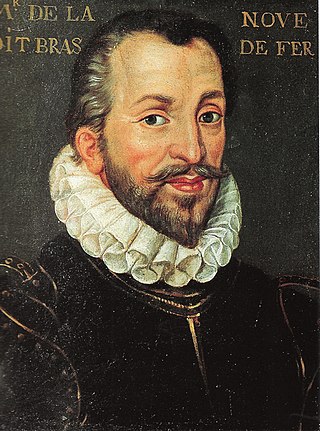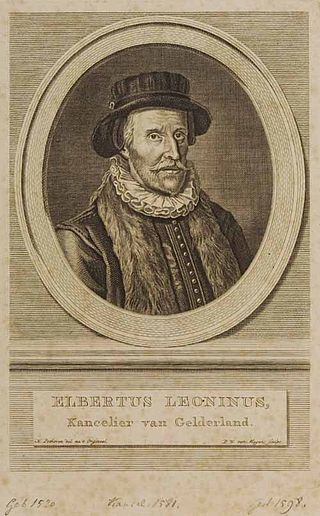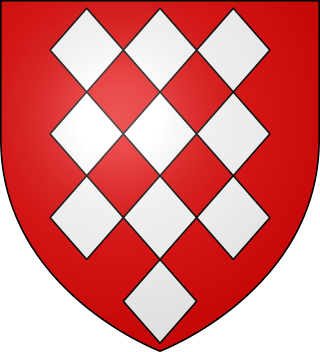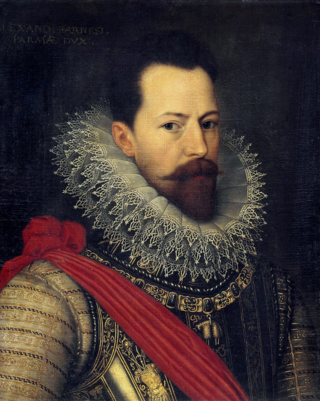The Union of Arras was an alliance between the County of Artois, the County of Hainaut and the city of Douai in the Habsburg Netherlands in early 1579 during the Eighty Years' War. Dissatisfied with the religious policies of rebel leader Prince of Orange and the States General of the Netherlands, and especially the rise of the radical Calvinist Republic of Ghent since October 1577, they signed a declaration on 6 January 1579 about their intent to offer a vigorous defense of the Roman Catholic religion against what they saw as encroachments by Calvinists in other provinces. These signatories would begin negotiations for a separate peace with the Spanish Crown, which resulted in the Treaty of Arras of 17 May 1579.
The Pacification of Ghent, signed on 8 November 1576, was an alliance between the provinces of the Habsburg Netherlands. The main objectives were to remove Spanish mercenaries who had made themselves hated by all sides due to their plundering, and to promote a formal peace with the rebellious provinces of Holland and Zeeland.

The County of Artois was a historic province of the Kingdom of France, held by the Dukes of Burgundy from 1384 until 1477/82, and a state of the Holy Roman Empire from 1493 until 1659.

François de la Noue, called Bras-de-Fer, was one of the Huguenot captains of the 16th century. He was born near Nantes in 1531, of an ancient Breton family.

Elbertus Leoninus was the Latinized name of Elbert de Leeuw, Dutch jurist and statesman, who helped negotiate the Pacification of Ghent.

Maximilien de Hénin-Liétard, Count of Boussu was a soldier and statesman from the Habsburg Netherlands. During the Eighty Years' War he was the royalist stadtholder of Holland, Zeeland and Utrecht from 1567 until he was made a prisoner of war during the Battle on the Zuiderzee in 1573. After being freed under the terms of the Pacification of Ghent he changed sides and became commander in chief of the forces of the States-General of the Netherlands.
Philippe René Nivelon Louis de Sainte-Aldegonde, Lord of Noircarmes was a statesman and soldier from the Habsburg Netherlands in the service of Charles V, Holy Roman Emperor, and Philip II of Spain. He gained notoriety during the suppression of Calvinist insurrections, especially at Valenciennes in 1566-7, and as a member of the Council of Troubles at the start of the Eighty Years' War. He was stadtholder of Hainaut from 1566, and of Holland, Zeeland and Utrecht from 1573 until his death.
Robert de Melun, viscount of Ghent and marquis of Roubaix, was a nobleman from the Low Countries who fought in the Eighty Years' War.

Philip de Lalaing was 3rd Count of Lalaing and Lord of Escornaix and Wavrin.

Jean Sarazin, Latinized Joannes Saracenus (1539–1598) was an abbot of the Benedictine Abbey of St. Vaast, Arras, and the third archbishop of Cambrai.
Jean Six (1533–1586) was a theologian and bishop of Saint-Omer.

The Treaty of Arras of 17 May 1579 was a peace treaty concluded between the Spanish Crown, represented by Alexander Farnese, Duke of Parma, and representatives of the County of Hainaut, the County of Artois, and the cities of Douai, Lille, Orchies and Arras, all members of the Union of Arras, that had been formed on the 6 January 1579.
The Malcontents in the context of the Eighty Years' War or the Dutch Revolt were a faction of Catholic nobles in Hainaut and Artois who openly opposed William the Silent, also known as William of Orange, the leader of the States General of the Netherlands in the Union of Brussels of the Habsburg Netherlands during the period after the adoption of the Pacification of Ghent. They formed the Union of Arras in January 1579 and negotiated a separate peace with the Spanish Crown, represented by the royal governor-general Alexander Farnese, Duke of Parma, in the form of the Treaty of Arras (1579), signed on 17 May 1579.
Frédéric Perrenot (1536–1600), lord of Champagney, baron of Renaix, was a soldier and diplomat in Habsburg service.
Guillaume de Pamele or Willem van Pamele (1528–1591) was a royal office-holder in the Habsburg Netherlands during the Dutch Revolt. He served as president of the Council of Flanders and of the Privy Council of the Habsburg Netherlands.
Guillaume Le Vasseur, lord of Valhuon, was a nobleman of Artois who served Philip II of Spain as a soldier and diplomat during the Dutch Revolt.
Mathieu Moulart (1536–1600), alternatively Moullart or Moulard, was an abbot and bishop in the Habsburg Netherlands.

The period between the Pacification of Ghent, and the Unions of Arras and Utrecht constituted a crucial phase of the Eighty Years' War between the Spanish Empire and the rebelling United Provinces, which would become the independent Dutch Republic. Sometimes known as the "general revolt", the period marked the only time of the war where the States–General of all Seventeen Provinces of the Habsburg Netherlands, except Luxemburg, were in joint active political and military rebellion against the Spanish Imperial government through the Pacification of Ghent. The Pacification formulated several agreements amongst the rebellious provinces themselves, and laid down their demands – including the immediate withdrawal of foreign troops from the Netherlands, restitution of old rights and privileges, and self-rule – to king Philip II of Spain.

The years 1579–1588 constituted a phase of the Eighty Years' War between the Spanish Empire and the United Provinces in revolt after most of them concluded the Union of Utrecht on 23 January 1579, and proceeded to carve the independent Dutch Republic out of the Habsburg Netherlands. It followed the 1576–1579 period, in which a temporary alliance of 16 out of the Seventeen Provinces' States–General established the Pacification of Ghent as a joint Catholic–Protestant rebellion against the Spanish government, but internal conflicts as well as military and diplomatic successes of the Spanish Governors-General Don Juan of Austria and Alexander Farnese, Duke of Parma split them apart, finally leading the Malcontent County of Artois, County of Hainaut and city of Douai to sign the Union of Arras on 6 January 1579, reverting to Catholicism and loyalty to the Spanish crown. In response, most of the remaining rebel provinces and cities would forge or later accede to the Union of Utrecht, a closer military alliance treaty that would go on to become the most important fundamental law of the United Provinces, who on 26 July 1581 proclaimed the Act of Abjuration, a de facto declaration of independence from Spain. While the nascent polity was struggling to find a new sovereign head of state, including Matthias of Austria, Francis of Anjou, William "the Silent" of Orange and Robert of Leicester, before giving up and deciding to become a republic by passing the Deduction of Vrancken on 12 April 1588, the Duke of Parma continued his successful military and diplomatic offensive, bringing ever more provinces and cities in the southern, eastern and northeastern parts of the Netherlands back into royalist hands. Parma's reconquests more or less stalled after the Fall of Antwerp (1585), and finally came to an end with the failure of the Spanish Armada and Philip II ordered him to intervene in the French Wars of Religion to prevent the Succession of Henry IV and France becoming a Protestant kingdom. These developments gave rise to a new phase, the Ten Years (1588–1598), that saw significant conquests by the Dutch States Army under the leadership of stadtholders Maurice of Nassau and William Louis of Nassau-Dillenburg, and the Dutch Republic's rise as a commercial great power.









